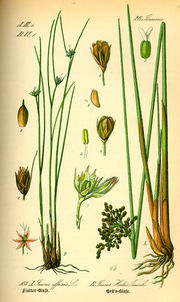Juncus
| Juncus subsp. var. | ||||||||||||||||||||||||||||||||||||||||||||||||||||||||
|---|---|---|---|---|---|---|---|---|---|---|---|---|---|---|---|---|---|---|---|---|---|---|---|---|---|---|---|---|---|---|---|---|---|---|---|---|---|---|---|---|---|---|---|---|---|---|---|---|---|---|---|---|---|---|---|---|

|
|
| ||||||||||||||||||||||||||||||||||||||||||||||||||||||
| ||||||||||||||||||||||||||||||||||||||||||||||||||||||||
Juncus is a genus in the family Juncaceae. It consists of about 225 species of grassy plants commonly called rushes. They occur in all wet regions of the world, but rarely in the tropics. Many are considered weeds in gardening, and few are used as ornamental plants.
Juncus species are used as food plants by the larvae of a number of Lepidoptera species - see list of Lepidoptera which feed on Juncus.
| Standard Cyclopedia of Horticulture |
|---|
|
Juncus (classical name, to join). Juncaceae. Rushes. Grass-like plants growing in wet, rarely in dry, places and used for planting in bogs and around aquatic gardens. Plants send up from the rootstock several unbranched cylindrical sts. which bear a terminal, or sometimes apparently lateral, C3rme of greenish or brownish very small fls.: lvs. grass-like terete or flat: perianth of 6 rigid chaffy parts in 2 whorls; stamens short, either 3 or 6: caps. 3-celled or rarely 1-celled, many-seeded. Rushes differ from the true grasses and sedges in having a true perianth and a many-seeded pod.—The genus includes a host of species distributed throughout the temperate regions, but most of these are not in cult. Rushes are sold by dealers in native and aquatic plants. The kind used in making mats in Japan is procurable from dealers in Japanese plants. J. acuminatus, Michx., and other species may be used for water-gardens.— J. zebrinus, Hort. equals Scirpus Tabernaemontanus var. sebrinus.
|
Cultivation
Propagation
Pests and diseases
Species
|
|
Gallery
-
photo 1
-
photo 2
-
photo 3
-
Blunt-flowered Rush (Juncus subnodulosus)
-
Jointed Rush (Juncus articulatus) - from Thomé, Flora von Deutschland, Österreich und der Schweiz 1885
References
- Standard Cyclopedia of Horticulture, by L. H. Bailey, MacMillan Co., 1963
External links
- w:Juncus. Some of the material on this page may be from Wikipedia, under the Creative Commons license.
- Juncus QR Code (Size 50, 100, 200, 500)


